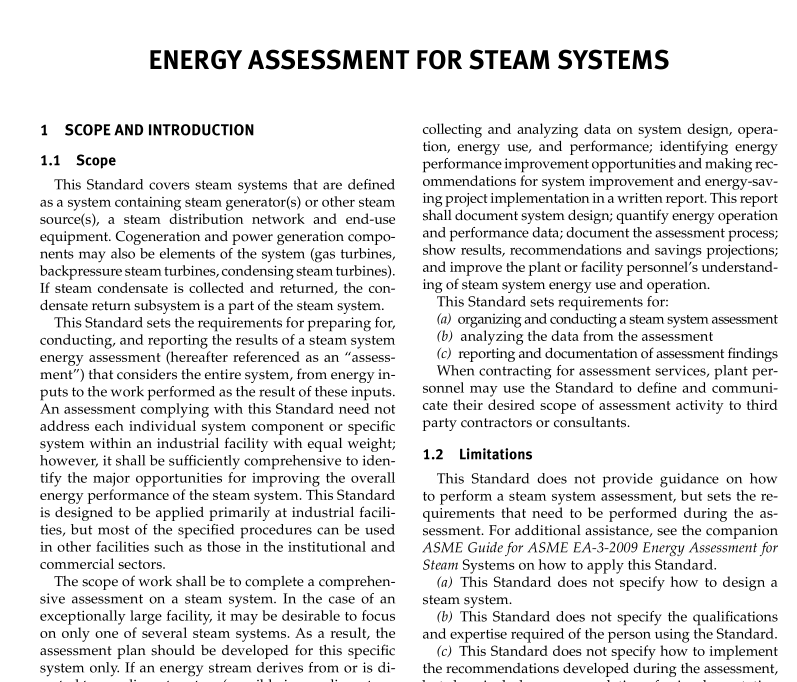ASME EA-3:2009 pdf download Energy Assessment for Steam Systems
1 sCOPE AND INTRODUCTION1.1Scope
This Standard covers steam systems that are definedas a system containing steam generator(s) or other steamsource(s), a steam distribution network and end-useequipment. Cogeneration and power generation compo-nents may also be elements of the system (gas turbines,backpressure steam turbines, condensing steam turbines).If steam condensate is collected and returned, the con-densate return subsystem is a part of the steam system.This Standard sets the requirements for preparing for,conducting, and reporting the results of a steam systemenergy assessment (hereafter referenced as an “assess-ment”) that considers the entire system, from energy in-puts to the work performed as the result of these inputs.An assessment complying with this Standard need notaddress each individual system component or specificsystem within an industrial facility with equal weight;
however, it shall be sufficiently comprehensive to iden-tify the major opportunities for improving the overallenergy performance of the steam system. This Standard
is designed to be applied primarily at industrial facili-ties, but most of the specified procedures can be used
in other facilities such as those in the institutional andcommercial sectors.
The scope of work shall be to complete a comprehen-sive assessment on a steam system. In the case of an
exceptionally large facility, it may be desirable to focuson only one of several steam systems. As a result, theassessment plan should be developed for this specific
system only. If an energy stream derives froms or es di-rected to an adjacent system (possibly in an adjacent en-
ergy-supplying or receiving facility), then the details ofthe energy streams (e.g., electricity, steam, natural gas)shall be considered as part of the assessment of the tar-get system.
Assessments involve collecting and analyzing data onsystem design, operation, energy use, and performance,and identifying energy performance improvement oppor-tunities for system optimization.An assessment may alsoinclude recommendations for improving resource utiliza-tion, reducing per unit production cost, reducing life cyclecosts, and improving environmental performance relatedto the assessed system(s). Assessment activities shallinclude but are not limited to engaging facility personnel collecting and analyzing data on system design,opera-tion, energy use,and performance; identifying energyperformance improvement opportunities and making rec-ommendations for system improvement and energy-sav-ing project implementation in a written report. This reportshall document system design; quantify energy operationand performance data; document the assessment process;show results, recommendations and savings projections;and improve the plant or facility personnel’s understand-ing of steam system energy use and operation.
This Standard sets requirements for:
(a) organizing and conducting a steam system assessment(b) analyzing the data from the assessment
(c) reporting and documentation of assessment findingsWhen contracting for assessment services, plant per-sonnel may use the Standard to define and communi-cate their desired scope of assessment activity to thirdparty contractors or consultants.
1.2Limitations
This Standard does not provide guidance on howto perform a steam system assessment, but sets the re-quirements that need to be performed during the as-sessment. For additional assistance, see the companionASME Guide for ASME EA-3-2009 Energy Assessment forStean Systems on how to apply this Standard.
(a) This Standard does not specify how to design asteam system.
(b)This Standard does not specify the qualificationsand expertise required of the person using the Standard.(c) This Standard does not specify how to implementthe recommendations developed during the assessment,but does include recommendations for implementationactivities.
(d)This Standard does not specify how to measureand validate the energy savings that result from imple-menting assessment recommendations.
(e) This Standard does not specify how to calibratetest equipment used during the assessment.
(fThis Standard does not specify how to estimate theimplementation cost or conduct financial analysis forrecommendations developed during the assessment.(g)This Standard does not specify specific steps requiredfor safe operation of equipment during the assessment.The plant personnel in charge of normal operation of theequipment are responsible for ensuring that it is operated
ASME EA-3:2009 pdf download
